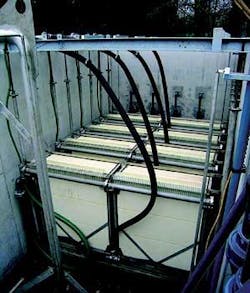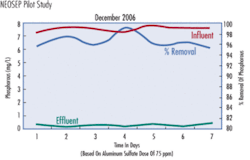System Combines Flat Sheet Membranes with Phased Biological Treatment
By Michael Sparks and Hervé Buisson
When immersed flat sheet membrane bioreactor (MBR) technology is equipped with a phased isolated control scheme, the result is a plant with a smaller footprint that produces a final effluent that does not require final clarification or tertiary filtration. Enhanced nitrogen and phosphorous removal can also be achieved.
Since 1993, research efforts on the NEOSEP® MBR, an immersed configuration MBR process available from Kruger Inc., have focused on optimizing both biological treatment and the separation unit (membrane) to enhance permeability, treated water quality and minimize sludge production and overall treatment costs.
With this Title 22 approved process, phased biological treatment is combined with flat sheet Polyvinylidene Fluoride (PVDF) membrane modules to create a compact system that meets stringent effluent requirements.
Treatment Process
The process consists of an aerobic biological process with integrated, low-pressure membrane modules – often configured with separate aeration tanks followed by membrane tanks. The process incorporates screens, activated sludge bioreactors, aeration, mixing and pumping equipment, all controlled by a PLC-based control system and SCADA system.
After pre-treatment (e.g. screening), raw water flows into the aerated and non-aerated biological tank where carbon, nitrogen and phosphorus-containing pollution is removed. Membrane filtration then separates the purified water from the activated sludge and the treated water is drawn off using a low-pressure pump or by gravity. Excess sludge is directly removed from the biological tank for dewatering.
Maintaining filtration performance is the key point to the process; this is based on different automated functions: backwash, air injection and chemical cleaning.
The flat sheet membrane elements (which have an average pore size of 0.08µ) separate the mixed liquor solids from the treated effluent, which is drawn through the membrane typically by a low pressure suction (<3 psi) pump connected to the filtrate. The tight pore structure of the membrane ensures the removal of suspended solids without necessitating the formation of a cake layer across the surface, as is the case with other flat sheet membranes. In the backwash phase, fouling is prevented by pumping back the permeate in counter-current flows through the membranes. During this phase, scour air continuously flows upward and also helps to release the sludge cake.
The membrane choice and process configuration are driven by energy considerations, the need to minimize fouling, and the ability to recover membrane performance in the case of continuous accidental fouling.
In a typical application with screened influent with a total suspended solids (TSS) concentration of 220 mg/L and mixed liquor with a TSS concentration of 12,000 mg/L, the membrane removes all of the solids with typical effluent TSS in the non-detectable range and turbidity of 0.05 NTU. For treatment of domestic wastewater, sludge production is very low, due to low food-to-microorganism (F/M) ratios and longer sludge aging in the reactor.
Enhanced Nitrogen Removal
The immersed, flat sheet MBR system can be configured with nitrification and denitrification zones for nitrogen removal. A proprietary phased isolation technology control scheme can be incorporated into the NEOSEP MBR. Phased MBRs inherit the features of Phased Isolation Technology (providing flexible anoxic/oxic phases) with an absolute barrier that provides the liquid/solid separation. Phased MBRs achieve nitrification and denitrification without the need for the pumped recirculation of nitrified mixed liquor from the aeration to the anoxic reactors.
The system consists of a pair of equal volume bioreactors, in which conditions are alternated between aerobic and anoxic. Instead of recycling nitrate rich mixed liquor at a high rate from an aerobic reactor to a dedicated anoxic tank in order to achieve denitrification, the conditions within each reactor are simply alternated between aerobic and anoxic. Moreover, by controlling the alternation of the flow path of sludge recycled from the membrane tanks to the main bioreactors, the phased MBR eliminates re-introduction of high DO mixed liquor into the anoxic phases for most of the time, thereby eliminating the internal recycle stream, providing a simpler and lower cost nitrogen removal alternative.
The major feature of phased isolation technology is that anoxic and oxic phase hydraulic retention times (HRT) can be changed to accommodate influent load variations, temperature changes, and effluent requirements. This feature enables phased isolation technology to improve denitrification performance and save aeration energy at the same time by reducing the aeration phase length if nitrification is complete or meets the requirements. Advantages of phased MBR technology over the conventional two-loop process includes greater flexibility in operation, improved TN performance, and aeration energy savings.
Enhanced Phosphorus Removal
Total phosphorus reduction down to 0.05 mg/L can be achieved with this MBR system. When plants are required to have phosphorus levels this low, the process design includes a three-stage anaerobic selector.
Most anaerobic selectors are designed as a multi-staged reactor where the influent wastewater and return activated sludge (RAS) are blended together in the first stage. The introduction of nitrates and dissolved oxygen from the RAS into the anaerobic selector can be detrimental to selecting and cultivating a rich culture of phosphorus removing bacteria. The recirculation of nitrates to the anaerobic selector results in additional denitrification and the consumption of soluble BOD and volatile fatty acids present in the raw wastewater that are required for biological phosphorus removal. Therefore, plants requiring optimum phosphorus removal must ensure that nitrate is not recycled to the anaerobic selector.
With the development of NEOSEP MBR this dilemma has been overcome by staggering the RAS and influent streams in a multi-stage reactor. This flow arrangement, known as the Block and Hong process modification, allows for ideal anaerobic conditions and a high soluble BOD:P ratio to be maintained, as required for effective phosphorus removal.
In addition to phosphorus removal, the anaerobic selector prevents the excessive growth of filamentous bacteria responsible for a common problem at treatment facilities, referred to as sludge bulking. By passing the RAS through the anaerobic selector, the growth of filamentous bacteria, which are obligate aerobes, is inhibited. This results in the formation of a dense, rapidly settling floc which increases the RAS concentration, thereby decreasing the volume of RAS that must be pumped to the head of the activated sludge process.
However, to achieve effluent P levels down to 0.05 mg/L, systems need to perform both chemical and biological phosphorus removal. Alum or ferric chloride is typically added to coagulate and take up the remaining phosphorus.
No Final Clarification, Tertiary Filtration
The primary advantages in using the NEOSEP MBR process compared to conventional treatment include high treated water quality, a small plant footprint, less sludge production and greater operational flexibility. With immersed flat sheet MBR technology the result is not only a smaller footprint plant but also one that produces a final effluent of such high clarity and low bacteria count that no final clarification or tertiary filtration is required. Plus, because a high sludge concentration can be maintained independently of settling qualities, this provides for high volumetric capacities.
Settlement has no effect on the quality of treated water in the MBR process because solids and colloids are eliminated through membrane separation. In addition, sludge retention time (SRT) can be controlled independently from hydraulic retention time. As a result, lengthy SRTs can be maintained, allowing for complete retention of slow-growing microorganisms such as nitrifying bacteria and thereby further providing for greater operating flexibility.
Protecting an Outer Bank Community
The NEOSEP MBR process is suited for the upgrading of conventional treatment plants and for applications in environmentally sensitive areas, such as the Outer Banks, the 200-mile long string of narrow barrier islands off the coast of North Carolina. The process has recently been selected by Carolina Water Services of Charlotte, NC, to upgrade the existing Monteray Shores wastewater treatment facility.
The community of Monteray Shores, located in Corolla, NC, is situated on the northern Outer Banks between the sound and the ocean. In a place as pristine as the Outer Banks, it is critical that wastewater be treated to a very high level of quality with a minimum of environmental impact. The community needed to increase treatment capacity to meet anticipated growth and improve effluent quality. Carolina Water Services determined the MBR technology would provide the treatment performance required.
The state of North Carolina Department of Environment and Natural Resources (DENR) has approved the upgraded facility to treat an average daily flow of 0.52 mgd and requires the facility to achieve an effluent BOD < 5.0, TSS < 3.0, TN < 4.0, and TP < 1.0. Anticipated completion date for the new facility is late December.
About the Authors:
Michael Sparks is MBR Product Manager, Biological Treatment Systems, Kruger Inc., a Veolia Water Solutions & Technologies North America company. Hervé Buisson is V.P.-Process for Veolia Water Solutions & Technologies North America. Veolia Water Solutions & Technologies serves the municipalities and industries by providing the complete range of water and wastewater solutions.




